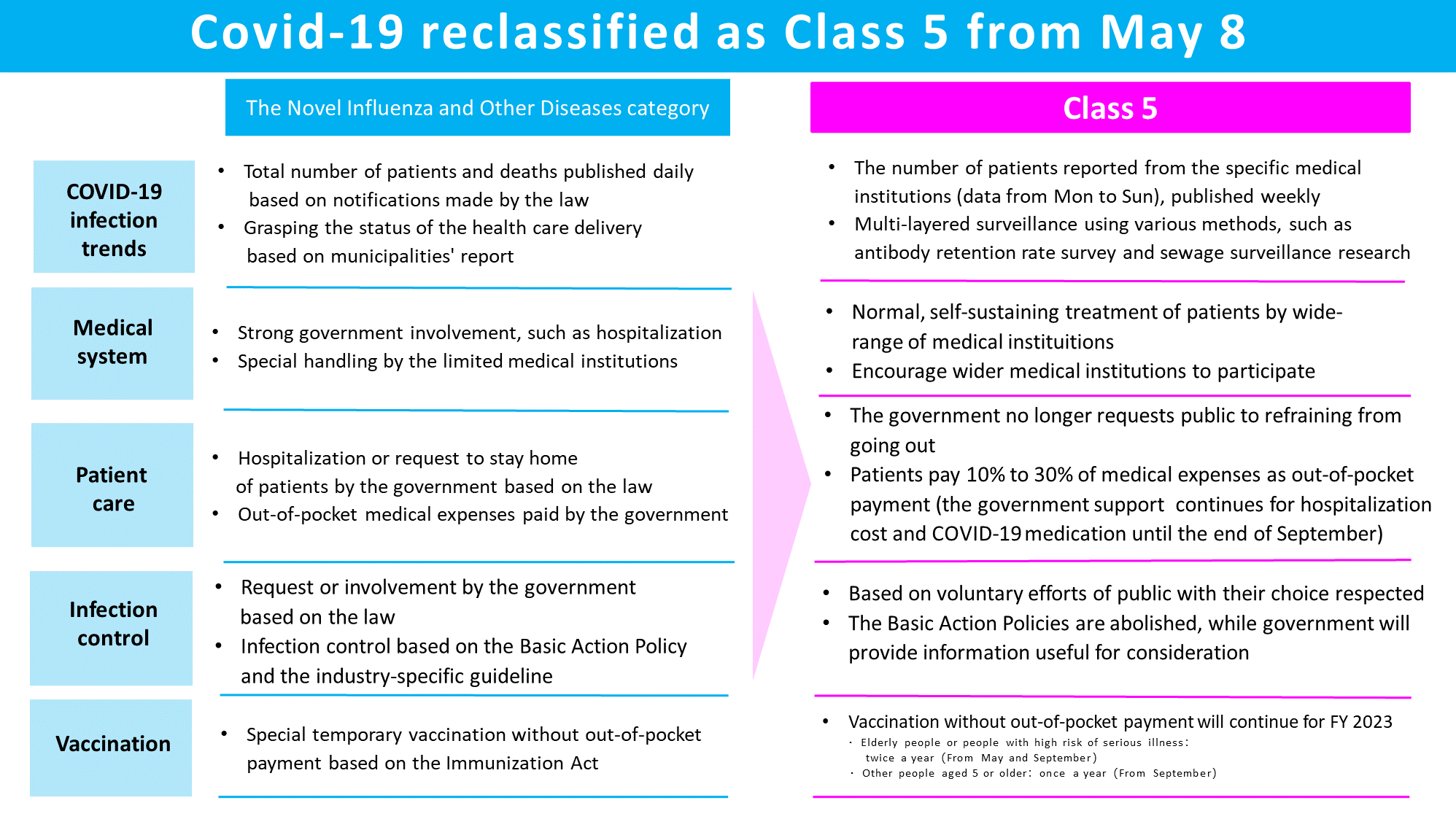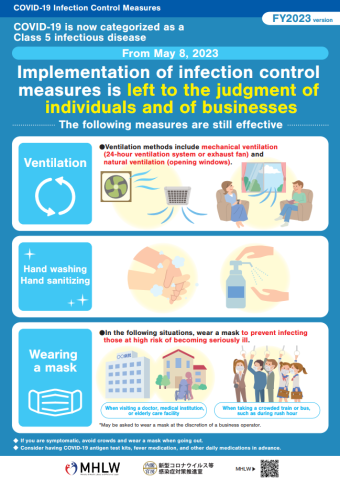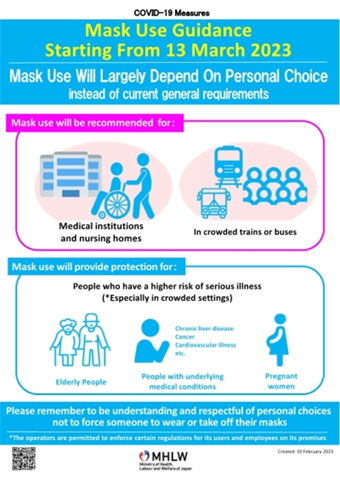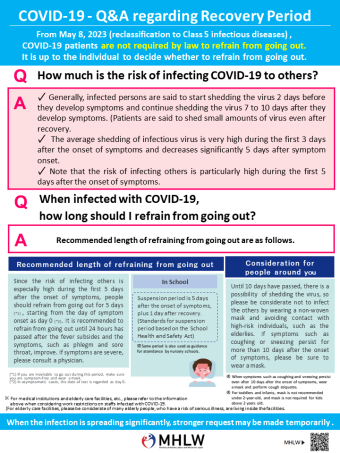Response to COVID 19 (Novel Coronavirus) after the classification change
Japan has reclassified COVID-19’s category to Class 5 under the Act on the Prevention of Infectious Diseases and Medical Care for Patients with Infectious Diseases*
(* hereafter the Infectious Diseases Control Law)
The Infectious Diseases Control Law classifies infectious diseases into Class 1 through 5 based on their infectiousness and severity, in which measures that the government can take to prevent the spread of infections differ.
COVID-19 was categorized as “the Novel Influenza and other diseases category”, which is equivalent to Class 2. However, starting from May 8, 2023, it is reclassified as Class 5.
Japan’s infection control measures change from those based on the government’s requests and interventions to ones that is based on the voluntary efforts of individuals, respecting individuals’ choices.
|
After the classification change:
● The government no longer requests individuals to take unified basic infection control measures in daily life.
● People infected with COVID-19 and those who have been in close contact with COVID-19 patients are no longer requested to refrain from going out.
● COVID-19 patients can seek medical treatment in wider medical facilities instead of designated facilities.
● COVID-19 patients need to pay 10 to 30% of the medical expenses under the national health insurance program although the government intends to continue supporting for the part of medical bills for COVID-19 patients for the time being.
|
Major differences between infectious diseases classified in a category equivalent to Class 2 and those classified as Class 5.

Basic Infection Control Measures
| The government no longer requests public to take unified basic infection control measures. People are advised to take basic infection control measures, taking into consideration the necessity of such measures, economic and social feasibility, as well as sustainability. |
Please refer to the table below when individuals and business operators intend to implement basic infection control measures on a voluntary basis.
<Basic Infection Control Measures>
| Basic Infection Control Measures | Points |
| Masks | Wearing a mask is left to the judgement of individuals in principle, respecting individual choices. However, it is recommended to wear masks under certain circumstances. (See below) |
| Hand hygiene (including hand washing) / ventilation | The government does not uniformly request public for hand sanitization and ventilation. However, such efforts are still effective as basic infection control measures based on the characteristics of COVID-19. |
| Avoiding the “Three Cs” (closed spaces, crowded places and close-contact settings) and keeping sufficient distance from the others | The government does not uniformly request public to avoid the “Three Cs” and keep sufficient distance from the others. However, when the COVID-19 cases are on the rise, such measures are effective for elderly people and people at risk of developing severe COVID-19 symptoms. Thus, they are encouraged to avoid poorly ventilated venues, crowded places and close-range conversation. (When they cannot avoid such settings, wearing a mask is an effective measure.) |
<Points to consider>
● Expected effectiveness of measures (※) based on models of transmission
※ Measures against contact transmission, droplet transmission or aerosol transmission
● Cost-effectiveness
● Social feasibility (e.g., communication and social life)
● Implementation of other alternative infection prevention measures
<Recommendations on Masks>
To protect people who are at risk of developing severe COVID-19 symptoms, such as the elderlies, you are encouraged to wear a mask in the situations below.


<Previous measures (examples) taken by business operators>


<Previous measures (examples) taken by business operators>
| Previous (example) | Effectiveness of the measures | Points |
| Checking Body temperature | Identify people with fever and improve health management awareness | The government does not request business operators to take unified measures. Business operators make a decision on whether or not to implement measures based on its effectiveness, cost effectiveness, other infection control measures or alternative possibilities. <Examples> ・Restrooms in public space: Hand dryer can be used ・At buffet-style service: when using shared tools such as tongs, users shall sanitize their hands before using tools (use of disposable gloves not required) |
| Hand sanitizer placed at the entrance | Effective in disinfecting hands, Provide opportunities for hand sanitization to those who wish to do so |
|
| Installing partitions such as transparent acrylic panels, plastic sheets | Effective in blocking droplets physically, Good ventilation is important because partitions are unable to fully block aerosol |
Reference
Documents from the 120th COVID-19 advisory board (April 5, 2023)
Click here for reviewing attitudes toward mask-wearing
Click here for outlines of comments by Minister of Health, Labour and Welfare Katsunobu Kato on matters concerning this webpage at press conferences
Click here for reviewing attitudes toward mask-wearing
Click here for outlines of comments by Minister of Health, Labour and Welfare Katsunobu Kato on matters concerning this webpage at press conferences
Things to know when you get infected with COVID-19
| COVID-19 patients and those who have been in close contact with the infected persons are now not required to refrain from going out under the Infectious Diseases Control Law. It is up to the individual to decide whether to refrain from going out. Please refer to the information below when making a decision about outings. |
Q1: What is the risk of transmitting COVID-19 to others?
The period of which persons infected with COVID-19 shed the virus varies from person to person. However, infected persons are said to start shedding the virus 2 days before the onset of symptoms and continue shedding the virus 7 to 10 days after symptom onset.
Note that the risk of infecting others is particularly high during the first 5 days after the onset of symptoms because the average shedding of infectious virus is very high during the first 3 days after the onset of symptoms and decreases significantly after 5 days of symptom onset.
The amount of virus shed by persons infected with COVID-19 decreases as their symptoms, such as a fever and cough, improve, but patients are said to continue to shed small amounts of virus even after recovery.

Q2: When infected with COVID-19, how long should I refrain from going out?
| From May 8, 2023, patients are not required by law to refrain from going out. It is up to the individual to decide whether to refrain from going out. In making your decision, please refer to the following information. Also, we ask that people and businesses respect individual choice. At medical institutions and elderly care facilities, etc., please refer to the following information when considering work restrictions on staffs infected with COVID-19. For elderly care facilities, please be considerate of many elderly people, who have a risk of serious illness, are living inside the facilities. In addition, when the infection is spreading significantly, stronger request may be made temporarily. |
(1) Recommended length of refraining from going out
・Since the risk of infecting others is especially high during the first 5 days after the onset of symptoms, people should refrain from going out for 5 days (*1) , starting from the day of symptom onset as day 0 (*2).
and,
・If symptoms persist on day 5, it is recommended to refrain from going out until 24 hours after the fever subsides and the symptoms, such as phlegm and sore throat, improves. If symptoms are severe, please consult a physician.
(*1) If you are inevitable to go out during this period, make sure you are symptom-free and wear a mask.
(*2) In asymptomatic cases, the date of test is regarded as day 0.
(2) Consideration for people around you
Until 10 days have passed, there is a possibility of shedding the virus, so please be considerate not to infect the others by wearing a non-woven mask and avoiding contact with high-risk individuals such as the elderly. If symptoms such as coughing or sneezing persist for more than 10 days after the onset of symptoms, please be sure to wear a mask.
Q3: How will persons in "close contact" be handled from May 8?
Since the reclassification of COVID-19 as Class 5 infectious diseases on May 8, 2023, public health centers will not, in principle, identify people as "close contact" of COVID-19 patients. In addition, persons in "close contact" are not requested to refrain from going out by the law.
Q4: What should I do if a family member is infected with COVID-19?
If a family member or a person living with you is infected with COVID-19, please separate the rooms, if possible, and limit the number of caregivers as possible.
When you go out, please monitor your own health, especially during the first 5 days of the symptom onset of a family member infected with COVID-19, starting from the day of symptom onset as day 0. It is possible to develop symptoms until day 7. During this period, in addition to basic infection control measures such as hand washing, ventilation, etc., take other precautions such as wearing a non-woven mask and avoiding contact with high-risk individuals such as the elderlies. If symptoms develop, please refer to Q2.
Comparison between the recovery period before and after the reclassification of COVID-19’s category to class 5
| The recovery period requested based on the law before the reclassification to Class 5 | The recommended length of refraining from going out after the change based on personal decision from May 8 | |
| COVID-19 patients with symptoms | 7 days starting from the day of symptom onset* | 5 days starting from the day of symptom onset* |
| With 24 hours after recovery | ||
| COVID-19 patients without symptoms | Negative result from antigen test at day 5 or 7 days without test |
5 days, with the date of test as day 0 |
| Persons in "close contact" | Refrain from going out for 5 days | None |
Medical System and Government support
Special handling by the limited medical institutions based on the principle of hospitalization, will be replaced by normal, self-sustaining treatment of patients by wide range of medical institutions. After the reclassification, similar to those of seasonal influenza, health care insurance will be applied to medical expenses, and patients pay 10% to 30% of the cost as out-of-pocket payment. To prevent a sudden increase in the out-of-pocket expenditures, government will continue supporting certain inpatient and outpatient medical expenses for a limited period of time. |
Medical care delivery system
We will make a gradual transition toward a medical care delivery system in which COVID-19 patients can be treated at a wide range of medical institutions, taking necessary infection control measures and making necessary preparations.
For home care patients
The health follow-up centers and overnight care facilities that have been set up by the local governments will be closed, due to the end of notification of COVID-19 patients and end of request for infected persons to refrain from going out. However, in order to mitigate the impact on emergency medical care, outpatient care, and hospital beds, medical consultation and consultation in case of sudden changes in health condition, and overnight care facilities for the elderlies and pregnant women will continue for limited period.
▶Contact
Information on prefectural COVID-19 consultation offices (only in Japanese)
COVID-19 infection trends
Before the reclassification, the total number of patients and deaths were reported daily based on notification made based on the law. After the reclassification, the number of patients reported from the specific medical institutions will be the base of understanding outbreak trends. In addition, multi-layered surveillance using various methods will be established, and surveillance needed for countermeasures will be tracked continuously. |
For details, click here



